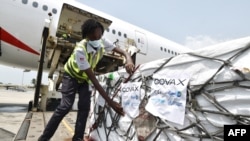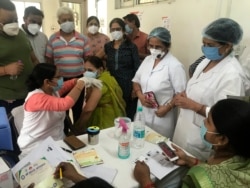The shortfall in America’s COVID-19 vaccination efforts — to reach 70% of the adult population by July 4 — pales in comparison to the international vaccine drive, which is on track to achieve just a fraction of the ambitious goal set last year.
COVAX, a global COVID-19 vaccine-sharing program, set the goal of distributing 2 billion shots by the end of 2021 to help vaccinate at least 20% of eligible low- and middle-income countries against COVID-19.
As of about the end of June, however, vaccine nonprofit Gavi reported that the program had delivered just 89 million doses.
Health experts say COVAX may fall short of its goal due to a lack of funds and vaccine supply shortages brought on by wealthy countries buying up the bulk of available doses.
“The global failure to share vaccines equitably is fueling a two-track pandemic that is now taking its toll on some of the world’s poorest and most vulnerable people,” said Tedros Adhanom Ghebreyesus, the director-general of the World Health Organization (WHO).
When the WHO, Gavi and the Coalition for Epidemic Preparedness Innovations formed COVAX in April of last year, they anticipated a lack of equitable vaccine access.
Wealthier nations reserved enough doses early on to vaccinate their populations several times over while lower- and middle-income countries were left vastly outcompeted in funds for buying their own supplies, said Gagandeep Kang, a professor of microbiology at the Christian Medical College in Vellore, India.
“There is a shortage of supply … and there are many countries that have an oversupply of vaccines,” said Kang, who also is part of several advisory groups for the WHO regional office of Southeast Asia.
Countries such as those that are part of the G-7 group of leading economies, which have extra reserves of vaccines, have committed to donating or supporting the production of more than 2 billion doses. Experts note that those commitments planned until the end of 2022 will be too slow and too little to reach COVAX’s or the WHO’s goals of vaccinating 40% of the world by the end of the year and 70% by the middle of 2022.
“This is the time when we should be there with all the vaccines that we have,” Kang said. “I think we are likely to fall short.”
Gaps in vaccination rates
Meanwhile, gaps in vaccination rates between high- and low-income countries remain large due to uneven access to the shots.
High-income countries, such as the United States, Britain and Israel, have delivered vaccines to more than half their populations, according to Our World in Data, while lower-income countries are struggling.
India has about 4% of its population fully vaccinated and is still recovering from its recent devastating outbreak in May. Brazil, where 12% of the people are fully vaccinated, recently reached a total of more than 500,000 COVID-19 deaths, the second-highest total in the world, according to Johns Hopkins University. The African continent, with only about 1% of the population fully vaccinated, is also facing fearsome third waves of infections.
Circulating viruses have also mutated into more potent variants and caused surges of infections that have prompted leaders to reimpose lockdown procedures, even in countries with relatively high vaccination rates.
That makes sharing vaccines more than just a humanitarian responsibility, WHO spokesperson Margaret Harris said. “It’s also just the most practical, sensible and self-interested thing we could all do.”
Other barriers to global distribution
“The lack of capacity for producing vaccine, which could lower costs and improve access, is a major driving factor [of vaccine access shortcomings],” said Jean Nachega, an expert in infectious diseases and epidemiology at the Johns Hopkins Bloomberg School of Public Health and the Stellenbosch University in Cape Town, South Africa.
Vaccine production requires facilities that many parts of the world don’t already have, explained Kang. Scaling up production from virtually zero COVID-19 vaccine doses from last year to millions, even billions this year requires swift but exact execution that is far from easy to achieve. Production also needs trained personnel and vast amounts of materials that are part of other supply chains with their own sets of challenges.
“It’s just a lot of hard work and a lot of resources,” Kang said.
Vaccine supplies are only part of the problem.
“Doses are one cost, but the other big costs are actually the logistics of getting it into countries,” Harris, of the WHO, said. To deliver and administer vaccines, a slew of additional people, equipment and planning is needed. Vaccination programs need to pay and train staff and health care workers. Regions need to set up facilities and have materials like syringes and wipes. Ships, planes and trucks need fuel for transporting doses. And vaccines need energy for refrigeration.
Transferring technology for manufacturing vaccines, such as licenses and techniques, to set up more regional facilities in countries in Africa could also improve access, Nachega said. “We really need to make all the effort in terms of technology transfer to speed up the process for local manufacturing of those vaccines.”
Toward the end of June, the WHO announced it would support South Africa in building the first COVID-19 vaccine technology transfer hub. The hub may help neighboring countries receive training and resources to set up more local manufacturing facilities as well, according to Nachega.
“At least one of the positives that could come out of this terrible suffering that the whole world’s seen is that finally, people seem to be understanding they have to be serious about genuine technology transfer,” said Harris.















